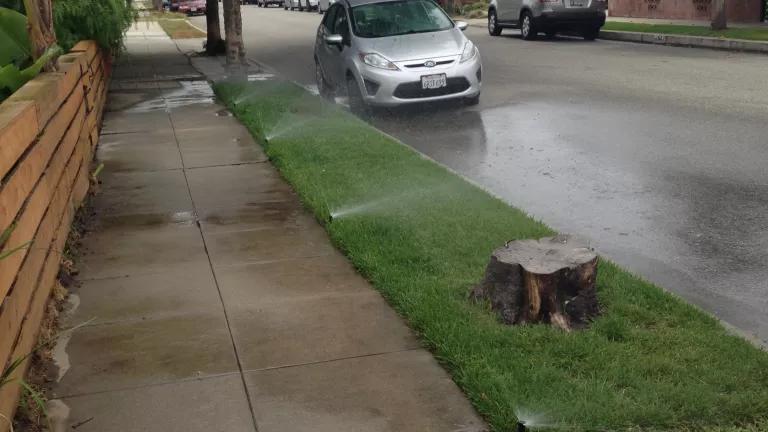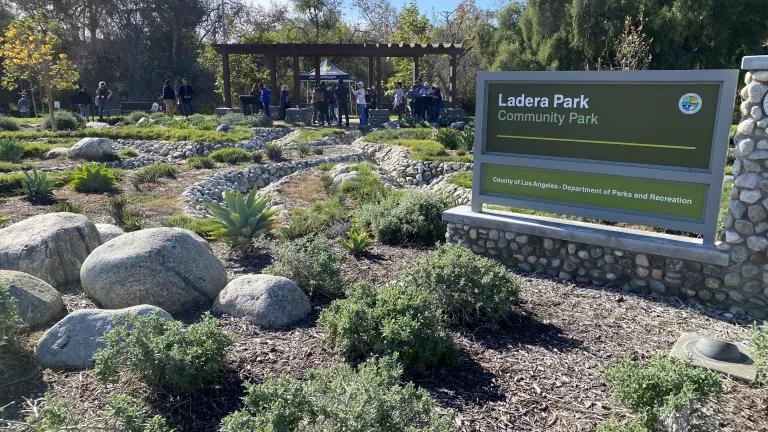Colorado Basin Shortages Point to Need for State Action
This year's unprecedented shortage declaration for the Colorado River should galvanize all Colorado Basin states to redouble their efforts to curtail wasteful and unnecessary uses of water and build more resilient communities.

Irrigation overspray in California
This year's unprecedented shortage declaration for the Colorado River should galvanize all Colorado Basin states to redouble their efforts to curtail wasteful and unnecessary uses of water and build more resilient communities. The issue gains urgency with the realization that next year is unlikely to bring significant relief. Action now is needed to maintain the supply drinking water in 2022, 2023, and beyond.
While agriculture uses the majority of Colorado River water, large metro areas in each of the Basin states all rely on water from the Colorado. And in six out of the seven states (all except Nevada), major cities taking river water are outside the basin, and send no return flows back. So most urban use of Colorado River water is entirely depletive, with no opportunity for reuse in the Basin.
States have the primary responsibility for overseeing water use to prevent waste and support health, public safety, and economic growth. Many important policies to promote water efficiency have been developed in the Colorado Basin states, but most are not universally applied. The technologies and practices that save water are well known and available today. States need not wait for the approval of the federal government or other Basin states before acting to ensure that water is used more efficiently. All that's holding them back are inertia, inattention, and indifference.
Here are nine opportunities to make real progress:
- Remove all non-functional turf grass. Kudos to Nevada, which has just enacted a ban on the use of Colorado River water for irrigating turf grass in public and commercial locations where grass is not needed for a playing surface or other active public use. Taking effect in 2027, this action will remove about 4,000 acres of unnecessary irrigation. If applied by all Basin states, the total would be well over 100,000 acres and could save more than 300,000 acre-feet of water each year. Other states should swing in behind Nevada’s lead.
- Adopt stronger efficiency standards for plumbing and equipment. Colorado, California, and Nevada all have stringent state standards for plumbing products. Nevada recently adopted efficiency standards for commercial dishwashers, and California for spray sprinklers. There is little to no price premium for water-efficient products, and despite the ex-President’s fulminations, you can get a very good shower from a new water-efficient showerhead. What’s holding up Arizona, New Mexico, Utah, and Wyoming?
- Require utilities to report their leakage, and to meet standards for reducing water lost from their pipes. All water distribution systems leak – some a little, some a lot. These losses add costs to all customers, and can be benchmarked with standardized auditing and reporting that has been endorsed by the drinking water industry. California and other states outside the basin (Georgia, Hawaii, Indiana, Tennessee) require standardized water loss audits, and are beginning to set performance targets for reducing water losses. Colorado River water is leaking from pipes in all seven states as you read this. But how much? And what are the owners of this infrastructure intending to do about it?
- Require all new urban landscapes to be water-efficient. It is said that to get out of a hole, first stop digging. Today’s robust housing construction is accompanied by new irrigated landscapes that will be thirsting for more water in the warmer decades to come. Statewide standards requiring water-efficient designs for all new landscapes are a place to start. Southern Nevada has had landscape requirements for years. California’s statewide regulations are an imperfect model, but without them the state would be in even worse shape today. States can adopt simple standards that can be easily enforced by local building officials.
- Ensure that existing buildings are water-efficient when they are sold or leased. Your home may be your castle for as long as you live there, but the sale or lease of property is a business that is already regulated by states and localities. Los Angeles and many other cities have long required “retrofit on resale,” a requirement that inefficient plumbing be removed from existing structures before, or within a specified period after, a real estate settlement. If expanded to new leases, the policy could have even greater impact in ensuring a more rapid transition to high-efficiency plumbing and appliances.
- Require water meters that are accurate enough to detect leaks. About 12% of all indoor water use is leakage, and that is leakage that is large enough to be recorded and billed by a water meter. The dirty secret of metrology, as it’s called, is that the trickle flow of a slow leak cannot be accurately recorded by most water meters, even when such leaks run up to 1,000 gallons a month or more. Meter accuracy standards have long been set by a committee dominated by meter manufacturers. It’s time for states to demand better and require that all new meters accurately capture the small flows resulting from leakage. Both new and existing technology is available to better record and bill for the water consumed by leaks, thereby encouraging their repair by customers.
- Invite low-income households to the table. Water suppliers across the West have much experience with water-saving incentive programs, but few have successfully and consistently engaged their low-income customers in the effort. Although water use rises with income, even low-income households can become more water-efficient, but lack the income for discretionary purchases of water-efficient plumbing and appliances. Elevating trusted community-based partners and designing programs to lower bills are key. States should ensure that water conservation programs have equitable outcomes, saving money as well as water for customers in all zip codes. Keeping water affordable is as important as keeping it available.
- Reduce cities’ discharge of treated fresh water into the ocean. This one is on California, the only Basin state with a coastline, although Utah might be a candidate as well. Legislation has been introduced, but not enacted, to phase out the discharge of municipal wastewater into the ocean, thereby retaining a steady supply of fresh water for reuse. The policy could be met by a combination of water efficiency, wastewater recycling, and reduced infiltration and inflows to sanitary sewers, each of which are beneficial in their own right. Getting to zero discharges may not be possible for the foreseeable future, but cutting discharges in half within 10 to 15 years is a worthwhile target that would reduce California's reliance on the Colorado and other sources of fresh water.
- Price water (and wastewater) sensibly. We hear many officials speak of the “value” of water, but in most states, the price of water and wastewater service is left to hundreds of local boards and city councils who typically lack rate-making expertise. Without oversight, drinking water rates often misalign costs and benefits and promote water use, rather than reward water efficiency. And in many areas, wastewater service is based on flat charges, unrelated to volume, making marginal use essentially free. Few states, and even fewer utilities, would want all water and wastewater rates to require state review and approval. But states could certainly require that local rate-setting boards make specific findings that their rates do not contain promotional features, and that core indoor uses remain affordable while discretionary outdoor uses carry more of the costs of running the system during periods of peak demand. The price signal is a powerful tool that is often overlooked in our management of drinking water.

No More Excuses
Adapting to the effects of a changing climate will involve many challenges and difficult choices. But the steps outlined here to safeguard our essential supplies of drinking water are NOT tough choices. It is no "struggle" for a state agency to amend its plumbing code to require more water-efficient plumbing in new buildings. It is not "burdensome" to require new water meters to be more accurate or new landscapes to be less thirsty, using existing technology and know-how. And it is not a "hard choice" to require water utilities to disclose their leakage, and their plans to reduce it. Water efficiency is a proven pathway to water reliability, and the tools are at our fingertips if we choose to use them. Los Angeles uses less water today than it did 50 years ago, even while supplying a population that has grown by nearly 50%. Yet even cities and states that have led the way in key areas of water efficiency still need to catch up in others. Now is the time to act on all the options at hand, and ensure that our demand for drinking water does not outstrip our diminishing supply.




